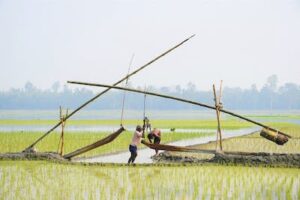
Table of Contents
ToggleIntroduction:
The history of irrigation in India is long and diverse, spanning several millennia. The need for irrigation in the Indian subcontinent arose from the irregular and seasonal nature of rainfall, particularly in regions with arid and semi-arid climates. Various civilizations in ancient India developed sophisticated techniques to harness and manage water resources for agriculture. Here is a brief overview of the history of irrigation in India:
Indus Valley Civilization (3300–1300 BCE):
The ancient Indus Valley Civilization, one of the world’s oldest urban cultures, existed in the northwestern part of the Indian subcontinent. The people of this civilization built advanced irrigation systems, including canals and wells, to support their agricultural activities. The Great Bath in Mohenjo-daro, one of the major cities of the Indus Valley, is believed to have had a sophisticated drainage system.
Vedic Period (1500–500 BCE):
The Vedic texts, such as the Rigveda, mention the construction of canals and water tanks (tanks or ponds) for agricultural purposes. The ancient Indians recognized the importance of water management and storage for sustaining agriculture.
Maurya and Gupta Empires (322 BCE–550 CE):
During the Maurya and Gupta periods, several large-scale irrigation projects were initiated. Chandragupta Maurya and Ashoka are credited with the construction of dams and canals. The Arthashastra, a treatise on statecraft written by Chanakya (Kautilya), discusses the principles of water management and irrigation.
Medieval Period (600–1700 CE):
Islamic rulers in India, such as the Mughals, also contributed to the development of irrigation systems. Babur, the founder of the Mughal Empire, initiated the construction of canals in the Gangetic plains. Akbar, one of the most prominent Mughal emperors, undertook significant irrigation projects, including the Agra Canal.
British Colonial Period (1757–1947):
The British colonial administration introduced modern irrigation methods in India. The construction of large dams and canal systems, such as the Ganges Canal, was undertaken to enhance agricultural productivity. Sir Arthur Cotton, a British engineer, played a key role in designing and implementing irrigation projects in southern India.
Post-Independence (1947 Onward):
After gaining independence in 1947, the Indian government continued to invest in irrigation infrastructure. The Green Revolution in the 1960s and 1970s, aimed at increasing agricultural production, led to the development of extensive irrigation networks. Major river valley projects, like the Bhakra Nangal Dam and the Hirakud Dam, were constructed to regulate water resources.
Contemporary Period:
In recent decades, there has been a focus on sustainable and efficient irrigation practices. Drip irrigation and sprinkler systems have gained popularity, especially in water-scarce regions. Government initiatives, like the Pradhan Mantri Krishi Sinchayee Yojana (PMKSY), aim to improve water use efficiency and promote water conservation in agriculture.
Today, irrigation continues to be a critical aspect of Indian agriculture, supporting the livelihoods of millions of farmers across the country. The challenge remains to balance the increasing demand for water in agriculture with sustainable and efficient water management practices.

Good sir ji
Good information
Recollection our country-history. After a long long time mind movement was at that era. Thanks
Very good 👍